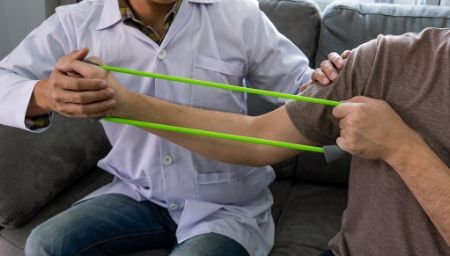
Seniors hold one of the highest rates of accidents that result in personal injury, and accidents can occur even when they are in the best of health. This can be a traumatic time for everyone, and injury assessment and rehabilitative therapy are crucial to the healing process. The two most common therapies for physical injuries are physical therapy and occupational therapy. Physical therapists and Occupational Therapists are required to have extensive certification and are highly dedicated to rehabilitating their patients.
PHYSICAL THERAPY:

The American Physical Therapy Association defines physical therapy as a practice that reduces pain and improves or restores mobility, in many cases without expensive and invasive surgery, and often reduces the need for long-term use of prescription medications and their side effects.Physical therapists work with medical problems or other health-related conditions that limit the ability to move or function on a day-to-day basis. They diagnose and treat patients of all ages and treatment plans involve techniques that promote movement, functionality, pain reduction, and disability prevention.
Physical therapists aid patients in preventing or managing their condition on a long-term scale. Physical therapy can take place in a wide range of settings, such as hospitals, outpatient clinics, home health agencies, private practices, schools, work settings, sports or fitness facilities, and nursing homes.Before beginning physical therapy there is a set of evaluations that take place to ensure that patients are given the proper care and treatment. Some of these evaluations are range of motion tests, x-rays, measuring limbs, ultrasounds, and so forth. Where there is pain and swelling, reduction method becomes the primary focus. Manual therapy, heat and cold stimulation, water stimulation, or electrical stimulation are some of the different methods of pain reduction.
Along with pain and swelling management, rehabilitative therapy also takes place. Rehabilitative therapy may involve stretching, exercise, core exercises, weight lifting, or cardio. Corrective rehabilitation is solidified by doing at-home exercises prescribed by the occupation therapist. Virtually any motion-related injury, such as broken limb recovery, back and neck pain, cancer-related problems, sprained joint recovery, cardiac rehabilitation, wound care, stroke recovery, and more are just what PT’s are there to remedy. They are dedicated to getting people back on their feet and to help them overcome their injuries.
OCCUPATIONAL THERAPY:

According to the American Occupational Therapy Association, or AOTA, occupational therapy asks, “What matters to do?” not, “What’s wrong with you?” Occupational therapy treats the impairment in action rather than just the impairment itself.
“Occupational therapy [practitioners] work across the lifespan to help people complete the activities that they want and need to do in order to live a fulfilling and independent life,” says Houston occupational therapy practitioner Allison Stobbe of the Medicare Pediatric Rehab Center. are Some of the tools that can be used to help patients accomplish everyday tasks are dressing aids, positioning splints, reachers, dressing aids, special dishes and utensils. With the aid of OT, patients are equipped to handle regular work and household activities through occupational therapy. Occupational therapists assist patients in learning how to relearn activities such as bathing, getting dressed, cooking, or general personal maintenance.
Occupational therapy practitioners focus on adapting the environment to the patient to give them autonomy and self-confidence. Some services given by OT’s are: an evaluation of the patient’s home, school, or work environments, guidance and education for family members and caregivers, and close contact with the patient’s doctor to ensure optimal care.
The patient’s needs are what determines what treatments are necessary. As their needs change, so does the treatment. Once an initial evaluation and interview with the patient occurs, the therapist helps the patient to set goals for themselves. As the patient’s needs change, the occupational therapist practitioner will modify treatment to meet what they need, moment by moment.
Occupational therapy focuses on living with the injury, and finding ways to make every day easier to work through. A broken limb or strained muscles can make simple things, like walking and dressing, feel impossible. They make it possible again.
Final thoughts:
Overall, the main differences between physical therapy and occupational therapy are in the purpose of treatment. Physical therapy exists to heal you. Occupational therapy helps you live out your day-to-day routines while you are healing. Seniors may find their daily tasks more difficult to accomplish as they age. Both types of therapy can often work together to make life more manageable. Both sets of therapists are there to make help make people stronger, healthier and more confident.


